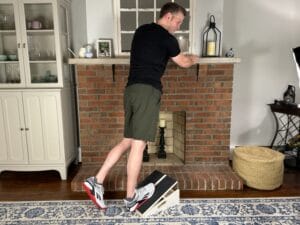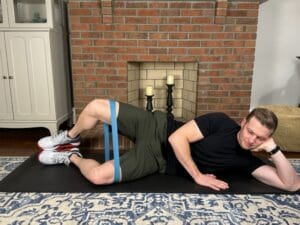Looking for the Best Exercises After an MCL Sprain?
If you’ve injured your medial collateral ligament (MCL), you’re likely dealing with pain on the inner side of your knee and difficulty trusting your leg when turning, walking, or climbing stairs. The good news? With the right exercises—done safely at home—you can reduce pain, restore motion, and rebuild knee stability.
As a Doctor of Physical Therapy, I’ve guided hundreds of patients through MCL sprain recovery. The key is performing the right exercises at the right time—progressing carefully from pain control to strength and balance.
Before you begin, you might also like:
Let’s start with the first stage, where your goals are to reduce pain, manage swelling, and gently restore knee motion.

Disclaimers and Disclosures: All information in this article is for informational and educational purposes only and should not be taken as individual medical advice. Additionally, this article contains affiliate links, meaning when you make a purchase, we make a small commission at no additional cost to you. For more information, see our full Disclaimers and Disclosures.
Phase 1 (0–2 Weeks): Early MCL Sprain Exercises at Home
During the first two weeks after an MCL sprain, the goal is to calm the knee, reduce pain and swelling, and gently restore motion. Focus on activating your leg muscles without putting sideways stress on the ligament.
This routine should be completed twice per day, stopping or modifying any exercise that increases your pain or symptoms.
This program was created by a Doctor of Physical Therapy and Orthopedic Clinical Specialist. As always, be sure to consult your healthcare provider before starting any new exercise regimen.
1. Hamstring Stretch with Strap
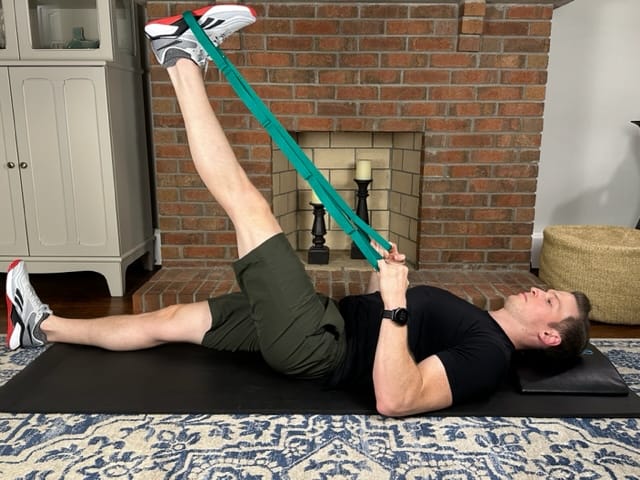
- Purpose: Targets tight hamstrings, which can restrict knee extension.
- Benefits: Reduces tension behind the knee and supports smoother motion.
- How to Do It:
- Lie on your back, loop a strap around your foot, and keep your leg straight.
- Lift your leg until you feel a stretch in the back of your thigh.
- Hold for 20 seconds, repeat 5 times.
- Helpful Link: Best Stretching Strap with loops can be found in the link below.
2. Calf Stretch with Strap
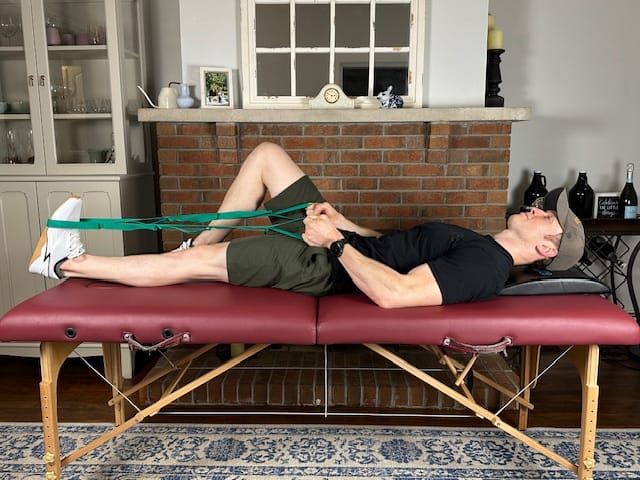
- Purpose: Stretch the gastrocnemius to improve ankle and knee mobility.
- Benefits: Promotes full knee extension and smoother gait for MCL recovery.
- How to Do It:
- Sit with your leg straight and loop a strap around the ball of your foot.
- Gently pull your toes toward you until you feel a stretch in the calf.
- Hold for 20 seconds, repeat 5 times.
- Pro Tip: Wear a shoe while doing this stretch to gain more leverage.
3. Quad Set
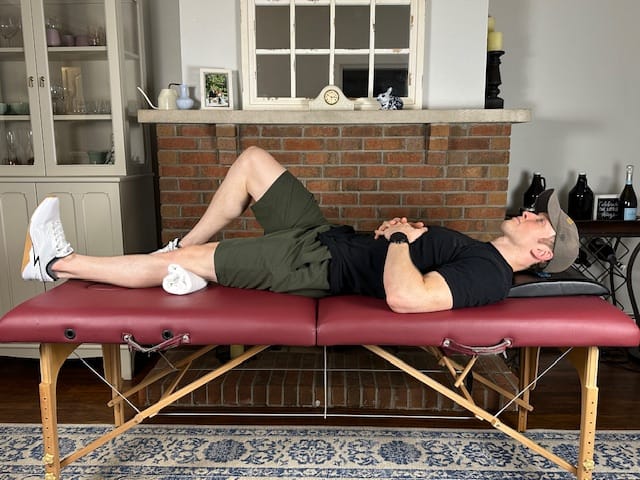
- Purpose: Activate the quadriceps to prevent early muscle loss.
- Benefits: Improves knee control and stability with MCL injury.
- How to Do It:
- Lie on your back with a towel roll under your ankle.
- Tighten your thigh to press the knee down.
- Hold for 2 seconds, perform 30 reps.
- Helpful Link: Best Thick Foam Mat to lie on for comfort can be found in the link below.
4. Straight Leg Raise

- Purpose: Builds quad strength without moving the knee joint.
- Benefits: Supports knee stability and improves muscle control following an MCL injury.
- How to Do It:
- Lie on your back with one leg bent and the other straight.
- Tighten your thigh and lift the straight leg to the height of your bent knee, then lower slowly.
- Repeat for 10 reps and complete 2 sets..
- Pro Tip: Keep toes pointed toward the ceiling and knee locked straight.
5. Short Arc Quad
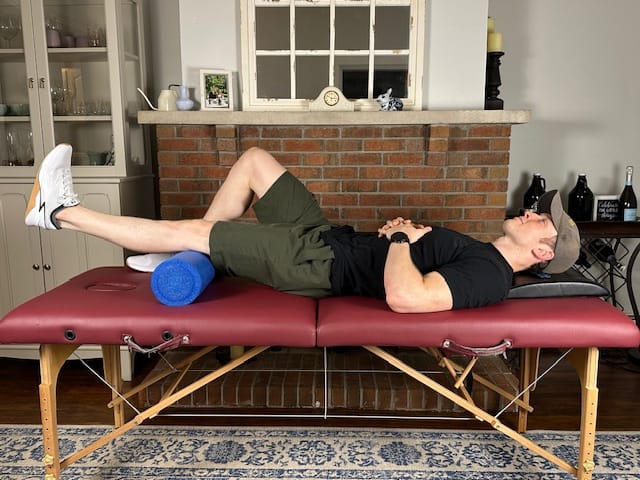
- Purpose: Early quad strengthening in a shortened range of motion.
- Benefits: Promotes knee extension and quad endurance after MCL sprain.
- How to Do It:
- Rest your knee over a foam roll while lying on your back.
- Straighten the knee by lifting your heel off the surface, pause briefly at the top.
- Lower slowly and repeat 20 times for 2 sets.
- Helpful Link: Best Ankle Weights and Foam Roll can be found in the links below.
6. Long Arc Quad
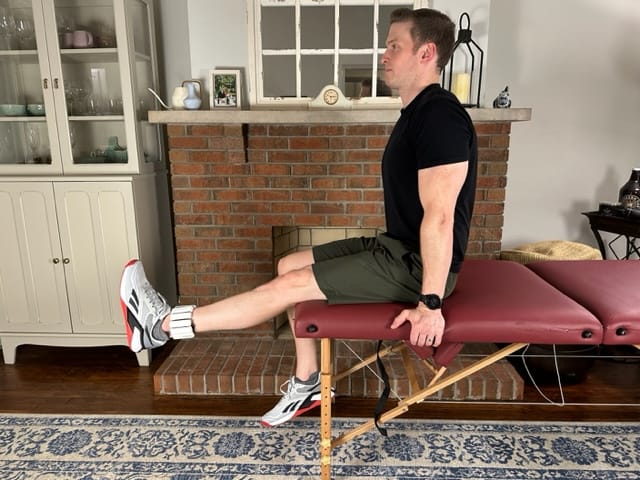
- Purpose: Strengthens the quadriceps through a larger range of motion.
- Benefits: Prepares the knee for walking and stairs.
- How to Do It:
- Sit upright with your thigh supported.
- Slowly extend your leg fully, hold briefly, then lower.
- Perform 20 reps, complete 2 sets.
- Pro Tip: Increase the ankle weight slowly to continue to build strength.
7. Heel Slides

- Purpose: Restores knee flexion in a safe, controlled motion.
- Benefits: Prevents stiffness and encourages motion after MCL injury.
- How to Do It:
- Loop a strap around your foot.
- Slide your heel slowly toward your buttocks, keeping your foot on the surface.
- Hold for 10 seconds and repeat 10 times.
- Helpful Link: Best Stretching Strap with loops can be found in the link below
Bonus: Ice Pack and TENS for MCL Injury Pain and Swelling
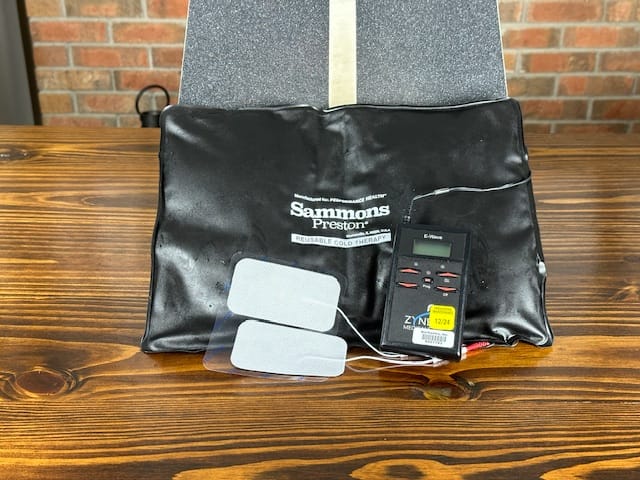
- Purpose: Reduce pain, inflammation, and muscle inhibition during early recovery.
- Benefits: Enhances comfort and reduces swelling, especially after exercise.
- How to Use:
- Place TENS pads just over the painful area of the knee.
- Apply ice for 10–15 minutes post-exercise.
- Pro Tip: Use the Ice Pack and the TENS Unit at the same time for maximum efficiency.
Phase 2 (2–4 Weeks): Strength & Stability MCL Sprain Exercises at Home
As pain improves and mobility returns, this phase introduces light strengthening and balance exercises to rebuild knee stability. Controlled movement helps your muscles begin sharing the load that once stressed the MCL.
These exercises should be completed once per day. Continue the stretching exercises from phase 1.
One other side note since you’ve made it this far: Although often called an MCL strain, this injury is technically a sprain—a tear or stretch of the medial collateral ligament on the inside of your knee. This is why you may hear or see these terms used interchangeably.
This program was created by a Doctor of Physical Therapy and Orthopedic Clinical Specialist. As always, be sure to consult your healthcare provider before starting any new exercise regimen.
1. Bridges with Band
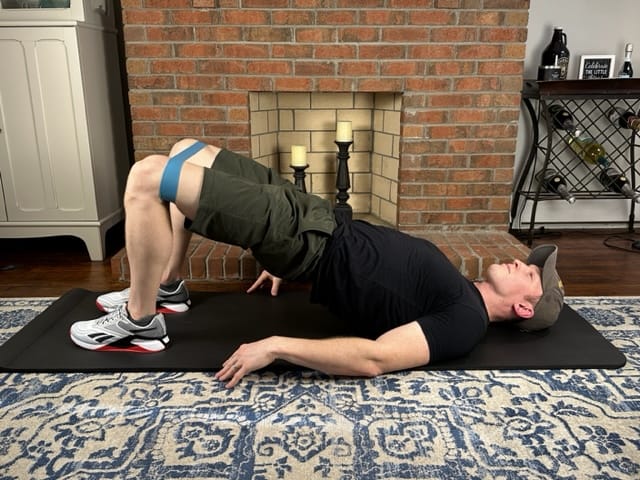
- Purpose: Activate glutes and hamstrings to reduce knee sprain from weak hips.
- Benefits: Strengthens glutes and hips to improve knee alignment.
- How to Do It:
- Lie on your back with knees bent and band above knees.
- Squeeze glutes and lift hips off the floor, hold for 2 seconds at the top.
- Perform 15 repetitions and complete 2 sets.
- Helpful Link: Best Resistance Bands can be found in the link below.
2. Heel Raises & Toe Raises
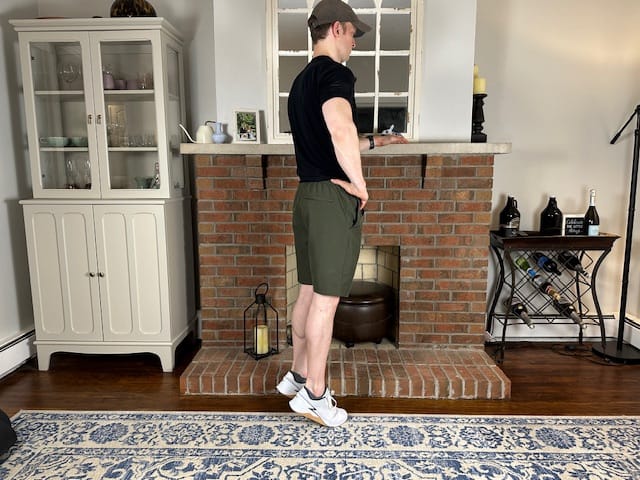
- Purpose: Strengthens calves and improves ankle rocker for proper gait.
- Benefits: Restores ankle motion and supports knee during walking.
- How to Do It:
- Stand tall and slowly rise onto your toes, then rock back onto your heels.
- Move with control, not momentum.
- Perform 15 reps, repeat for 2 sets.
- Pro Tip: Wear supportive Minimalist Shoes for ease while doing your standing exercises.
3. Cone Step-Overs
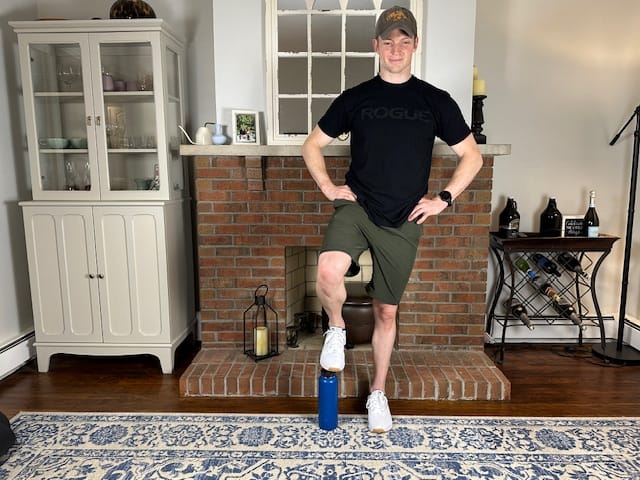
- Purpose: Encourages active knee bending and step control.
- Benefits: Improves coordination and confidence in gait mechanics after MCL injury.
- How to Do It:
- Set up a cone if front or your counter or other stable surface.
- Start on one side and step laterally over the cone, and then back to your start position.
- Over and back counts as one rep, complete 30 reps.
- Pro Tip: Use Stackable Cones to increase the height and make it a greater challenge.
4. Step-Ups (Forward)
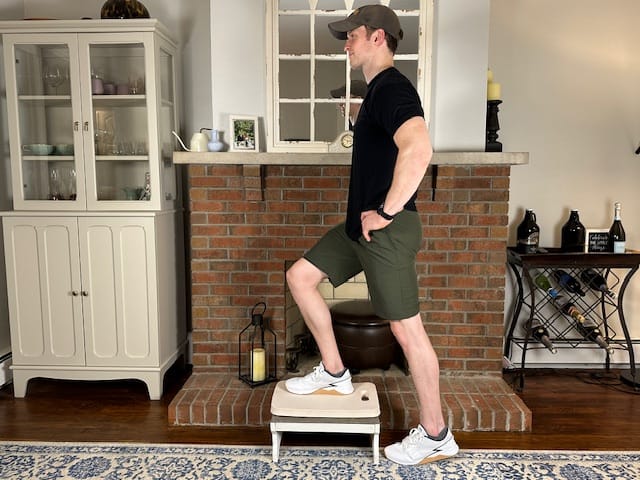
- Purpose: Builds quad strength through a functional motion.
- Benefits: Prepares for stairs, walking, and standing movements.
- How to Do It:
- Stand in front of a step with a counter nearby for balance.
- Step up with your injured leg, then lower with control.
- Repeat on the other side, perform 10 reps, complete 2 sets.
- Helpful Link: Best Adjustable Stepper can be found in the link below.
5. Lateral Step-Overs
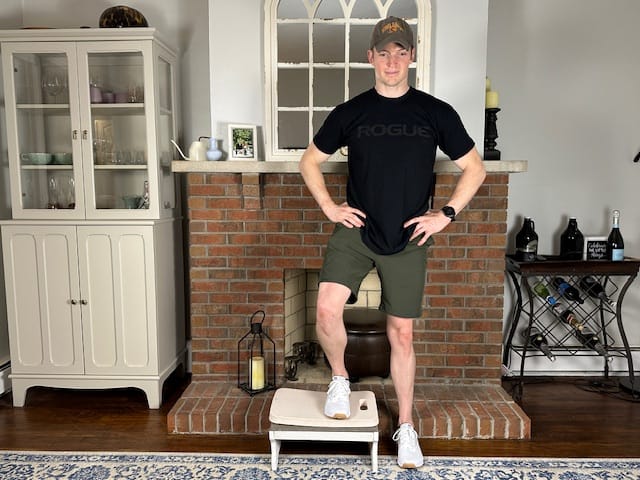
- Purpose: Strengthen hips and knees in a lateral movement.
- Benefits: Improves stability and medial-lateral control of the knee and MCL.
- How to Do It:
- Stand beside the step and step laterally up with your outer leg.
- Bring the other leg up, then step down to the other side.
- Return to start in the same fashion, complete 10 reps and perform 2 sets.
- Pro Tip: Focus on knee alignment as you go over the Adjustable Step, don’t let it collapse inward.
6. Single Leg Stance
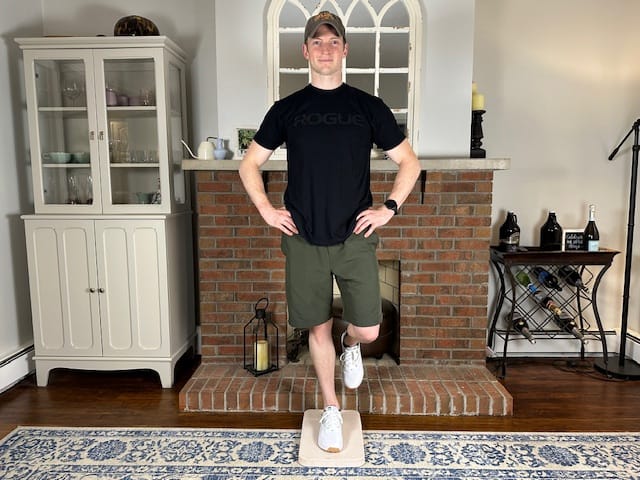
- Purpose: Retrains balance and joint proprioception after MCL injury.
- Benefits: Improves proprioception and knee stability to reduce re-injury risk.
- How to Do It:
- Stand on your injured leg in front of a counter for support.
- Lift your hands off the counter and balance for 15 seconds.
- Repeat on the other side and complete 5 sets.
- Helpful Link: Best Balance Pad can be found in the link below.
Phase 3 (4–6 Weeks): Strength, Control & Return to Functional Movement MCL Sprain Exercises
In the final phase, the emphasis shifts to strengthening, balance, and dynamic control as you prepare to return to higher-level activities. These exercises help restore confidence and knee stability for walking, stairs, or light sport.
These exercises should be completed 3-4 times per week. Perform the exercises from phase 2 on the alternate days and the stretching exercises from phase 1 if mobility is still limited.
This program was created by a Doctor of Physical Therapy and Orthopedic Clinical Specialist. As always, be sure to consult your healthcare provider before starting any new exercise regimen.
1. Calf Stretch on Slant Board
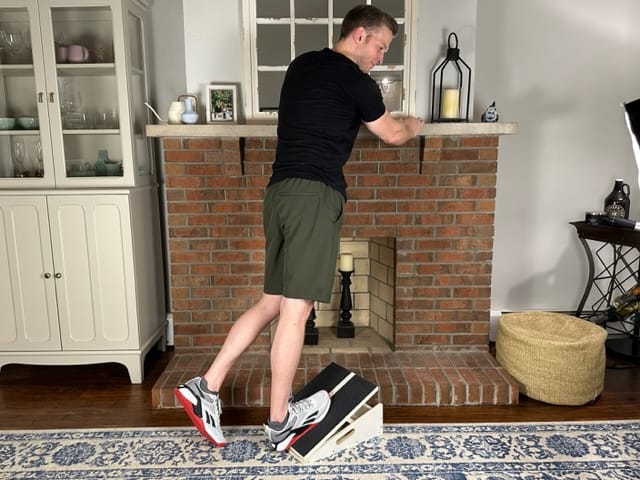
- Purpose: A more aggressive gastrocnemius stretch than strap-based stretching.
- Benefits: Reduces sprain through the knee during squatting and walking.
- How to Do It:
- Stand on a slant board with heels down and toes up.
- Lean forward until a stretch is felt in your calves.
- Hold for 20 seconds, repeat 5 times.
- Helpful Link: Best Slant Board can be found in the link below.
2. Goblet Squats
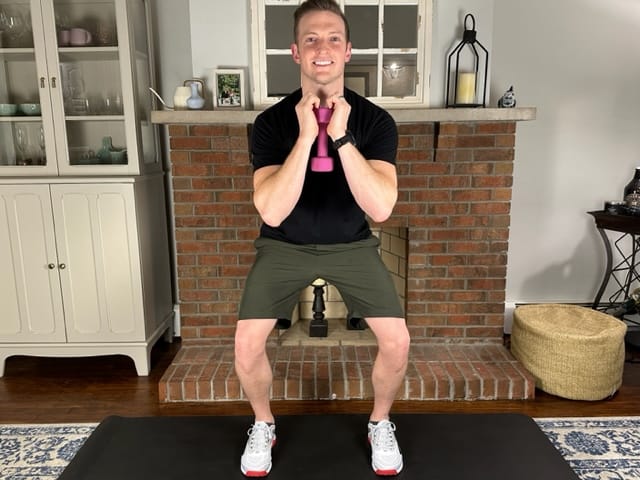
- Purpose: Builds compound strength in quads, glutes, and core in a functional movement pattern.
- Benefits: Improves squat mechanics, knee control, and lower body power.
- How to Do It:
- Hold a dumbbell close to your chest with elbows down.
- Squat down slowly, keeping your chest tall and knees aligned.
- Press through your heels to return to standing 10 times, complete 3 sets.
- Helpful Link: Best Dumbbell Weight can be found in the link below.
3. Sidesteps with Band
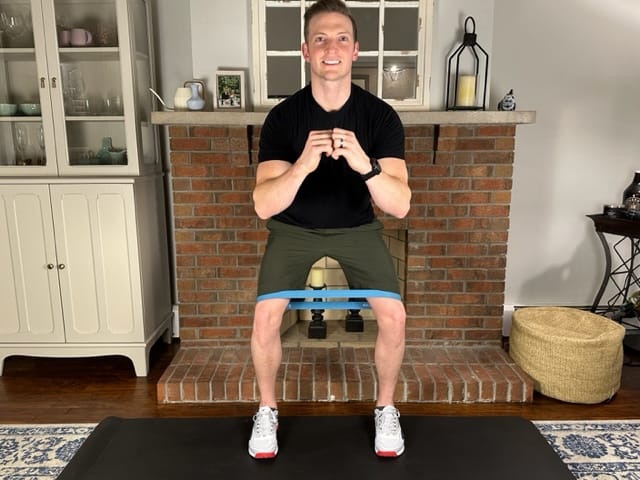
- Purpose: Strengthen hip stabilizers to control knee position.
- Benefits: Improves lateral stability and knee alignment.
- How to Do It:
- Place a resistance band just above your knees and lower into a mini squat.
- Step sideways slowly, keeping tension in the band.
- Perform 12-15 steps in each direction, rest, and repeat 3 times.
- Pro Tip: Keep your feet pointing straight ahead and your knees pressed into the Resistance Band—no dragging steps.
4. Step Downs

- Purpose: Trains eccentric quad control through a functional movement.
- Benefits: Builds stability for descending stairs and athletic motion.
- How to Do It:
- Stand on a step near your counter for light support.
- Slowly lower your opposite heel toward the ground without collapsing at the knee.
- Push through your stance leg to return to the top. Complete 2 sets of 10 reps.
- Pro Tip: Start on the lowest setting of an Adjustable Stepper and slowly increase the height as it gets easy.
Looking for a simple way to stay consistent?
👉 Download the free full MCL Tear Exercise Recovery Program + Exercise Tracker (PDF) to follow and log your daily progress.
Best MCL Sprain Exercises at Home: Final Thoughts
Recovering from an MCL sprain can feel slow and frustrating, especially when you want to return to your normal activities quickly. But having a clear, structured plan makes all the difference. As a physical therapist, I’ve seen how following targeted, progressive exercises can help people reduce pain, restore knee stability, and regain confidence—often without further injury.
This phased exercise program is the same one I use with patients in the clinic to safely rebuild strength, improve mobility, and protect the MCL as it heals. The key is consistency and listening to your body: perform these exercises daily or as tolerated, avoid movements that cause pain, and progress at your own pace. Within a few weeks, you should notice better knee motion, stronger supporting muscles, and greater confidence with everyday activities—all from the comfort of home.
Why Trust Physical Therapy Simplified for MCL Sprain Recovery Exercises?
At Physical Therapy Simplified, our mission is to provide an accessible, trustworthy source of physical therapy guidance that anyone can understand, follow, and benefit from. We want you to feel confident that you’re getting evidence-based advice and the best exercises for an MCL sprain—all designed to reduce pain and restore your highest functional potential.
This article was written by Andrew Harkins, PT, DPT, OCS, a licensed physical therapist with over twelve years of clinical experience. He is certified by the American Board of Physical Therapy Specialties as an Orthopedic Clinical Specialist and has successfully helped hundreds of patients recover from MCL injuries—both with and without surgery.
Andrew has also served as a teaching assistant at the University of Pittsburgh’s Doctor of Physical Therapy Program, where he contributed to musculoskeletal coursework with a special focus on knee rehabilitation and surgical treatment recovery strategies. His knowledge and hands-on experience ensure that the information you’re reading is not only accurate but clinically proven to help.

